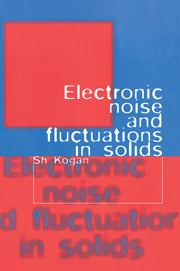Freshly Printed - allow 8 days lead
Couldn't load pickup availability
Electronic Noise and Fluctuations in Solids
Comprehensive, graduate-level text devoted to the physics of electronic fluctuations (noise) in solids.
Sh. Kogan (Author)
9780521070195, Cambridge University Press
Paperback / softback, published 31 July 2008
376 pages, 68 b/w illus. 4 tables
24.4 x 17 x 2 cm, 0.6 kg
'I … recommend this book to anyone interested in the theory of fluctuation phenomena and how it is applied in applied research.' Contemporary Physics
This book is devoted to the physics of electronic fluctuations (noise) in solids and covers almost all important examples of this phenomenon. It is comprehensive, intelligible and well illustrated. Emphasis is given to the main concepts, supported by many fundamental experiments which have become classics, to physical mechanisms of fluctuations, and to conclusions on the nature and magnitude of noise. The book also includes a comprehensive and complete review of flicker (1/f) noise in the literature. It will be useful to graduate students and researchers in physics and electronic engineering, and especially those carrying out research in the fields of noise phenomena and highly sensitive electronic devices, for example radiation detectors, electronic devices for low-noise amplifiers and quantum magnetometers (SQUIDS).
Preface
Part I. Introduction. Some Basic Concepts of the Theory of Random Processes: 1. Probability density functions. Moments. Stationary processes
2. Correlation function
3. Spectral density of noise
4. Ergodicity and nonergodicity of random processes
5. Random pulses and shot noise
6. Markov processes. General theory
7. Discrete Markov processes. Random telegraph noise
8. Quasicontinuous (Diffusion-like) Markov processes
9. Brownian motion
10. Langevin approach to the kinetics of fluctuations
Part II. Fluctuation-Dissipation Relations in Equilibrium Systems: 11. Derivation of fluctuation-dissipation relations
12. Equilibrium noise in quasistationary circuits. Nyquist theorem
13. Fluctuations of electromagnetic fields in continuous media
Part III. Fluctuations in Nonequilibrium Gases: 14. Some basic concepts of hot-electrons' physics
15. Simple model of current fluctuations in a semiconductor with hot electrons
16. General kinetic theory of quasiclassical fluctuations in a gas of particles. The Boltzmann-Langevin equation
17. Current fluctuations and noise temperature
18. Current fluctuations and diffusion in a gas of hot electrons
19. One-time correlation in nonequilibrium gases
20. Intervalley noise in multivalley semiconductors
21. Noise of hot electrons emitting optical phonons in the streaming regime
22. Noise in a semiconductor with a postbreakdown stable current filament
Part IV. Generation-recombination noise: 23. G-R noise in uniform unipolar semiconductors
24. Noise produced by recombination and diffusion
Part V. Noise in quantum ballistic systems: 25. Introduction
26. Equilibrium noise and shot noise in quantum conductors
27. Modulation noise in quantum point contacts
28. Transition from a ballistic conductor to a macroscopic one
29. Noise in tunnel junctions
Part VI. Resistance noise in metals: 30. Incoherent scattering of electrons by mobile defects
31. Effect of mobile scattering centers on the electron interference pattern
32. Fluctuations of the number of diffusing scattering centers
33. Temperature fluctuations and the corresponding noise
Part VII. Noise in strongly disordered conductors: 34. Basic ideas of the percolation theory
35. Resistance fluctuations in percolation systems. 36. Experiments
Part VIII. Low-frequency noise with an 1/f-type spectrum and random telegraph noise: 37. Introduction
38. Some general properties of 1/f noise
39. Basic models of 1/f noise
40./f noise in metals
41. Low-frequency noise in semiconductors
42. Magnetic noise in spin glasses and some other magnetic systems
43. Temperature fluctuations as a possible source of 1/f noise
44. Random telegraph noise
45. Fluctuations with 1/f spectrum in other systems
46. General conclusions on 1/f noise
Part IX. Noise in Superconductors and Superconducting Structures: 47. Noise in Josephson junctions
48. Noise in type II superconductors
References
Subject index.
Subject Areas: Electronics & communications engineering [TJ], Condensed matter physics [liquid state & solid state physics PHFC]


